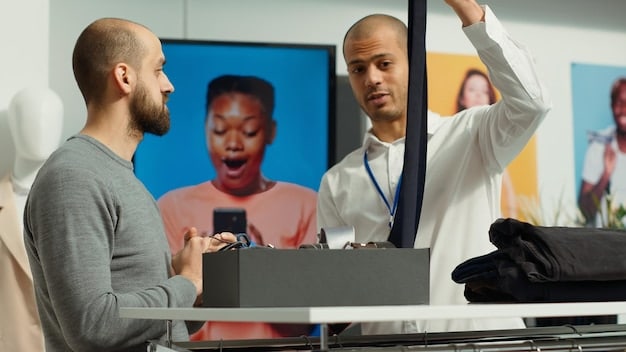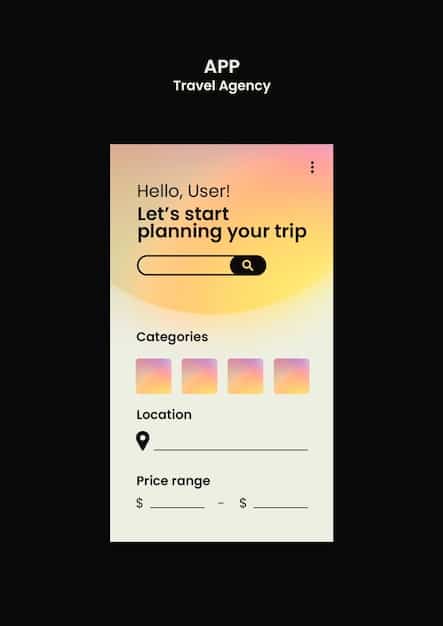Personalized Onboarding: Boost Customer Relationships and Retention

Personalized onboarding is a customer experience strategy that tailors the initial introduction and integration of new users to a product or service, leading to stronger customer relationships and improved long-term retention.
In today’s competitive market, simply acquiring customers isn’t enough; businesses need to focus on building lasting relationships. Personalized onboarding is a powerful strategy to achieve this, transforming new users into loyal advocates from the very beginning.
Why Personalized Onboarding Matters
Generic onboarding experiences often leave customers feeling lost and undervalued. Personalized onboarding, however, creates a tailored experience, increasing engagement and strengthening the customer-brand bond. It’s about making customers feel seen, heard, and understood from day one.
Moving beyond the basic tutorials and FAQ pages, personalized onboarding acknowledges that each customer is unique, and therefore, their onboarding journey should be too. This approach is not only more effective but also contributes significantly to customer satisfaction.
Increased Customer Retention
Personalized onboarding directly impacts customer retention. By addressing individual needs and pain points early on, businesses can lower the likelihood of customer churn. It’s about providing a support structure that caters to individual learning styles and preferences from the start.
Improved Customer Satisfaction
The positive impact on customer satisfaction is unmistakable. Customers who feel understood and supported during onboarding are more likely to have a positive perception of the company. This, in turn, boosts brand loyalty and word-of-mouth referrals.
- Personalized support leads to higher satisfaction rates.
- Tailored content addresses individual needs effectively.
- Proactive engagement builds stronger relationships early on.
- Personalization demonstrates that the company values each customer.
In conclusion, personalized onboarding isn’t just a nice-to-have, it’s a necessity for businesses that aim for long-term success and sustained growth, placing the customer experience at the forefront.
Understanding Your Customer Needs
Effective personalized onboarding starts with thoroughly understanding your customer base. Collecting and analyzing customer data is critical to design onboarding experiences that resonate personally. It’s about using insights to cater to specific requirements and expectations.
By gaining a deeper understanding of customer demographics, preferences, and challenges, businesses can fine-tune their onboarding processes to provide maximum value and satisfaction. This approach creates a sense of connection and trust between the customer and the brand.

Data Collection Strategies
Companies can employ various strategies to gather customer data, from onboarding surveys to behavioral tracking within the product or service. The key is to collect relevant data ethically, respecting customer privacy and preferences. This data then informs the personalization process.
Analyzing Customer Behavior
Analyzing how customers interact with your product or service provides valuable insights into their needs and pain points. This data can then be used to refine the onboarding experience, addressing specific challenges and improving overall satisfaction.
- Onboarding surveys gather valuable demographic and preference data.
- Behavioral tracking reveals how customers use the product or service.
- Feedback forms allow customers to express their needs and concerns.
- Support ticket analysis identifies common issues during onboarding.
Effectively understanding and leveraging customer data is the backbone of any successful personalized onboarding strategy, ensuring that the customer experience is consistently optimized.
Designing a Personalized Onboarding Flow
Creating a personalized onboarding flow involves mapping the entire customer journey and identifying opportunities for tailoring the experience to individual customer needs. It’s about crafting a sequence of interactions that resonate personally and provide value at every step.
A well-designed onboarding flow ensures that customers receive the right information at the right time, based on their specific requirements and goals. This reduces overwhelm and increases the likelihood of successful adoption and long-term engagement.
Interactive Tutorials
Instead of overwhelming users with lengthy documentation, interactive tutorials guide them through the core features of the product or service in an engaging and hands-on manner. These tutorials can be personalized to match individual learning styles and preferences.
Personalized Checklists
Personalized checklists provide a clear path for customers to follow during onboarding, highlighting the most important tasks and milestones based on their specific needs and goals. This helps reduce confusion and ensures that customers get the most out of the product or service.

- Interactive tutorials cater to different learning styles.
- Personalized checklists guide users through key tasks.
- Contextual help provides assistance when and where it’s needed.
- Progress tracking motivates users to complete onboarding.
By carefully designing and personalizing each step of the onboarding flow, businesses can create a more engaging and effective experience, leading to higher customer satisfaction and retention rates.
Tools and Technologies for Personalization
Leveraging the right tools and technologies can significantly enhance the effectiveness of personalized onboarding. These tools can automate personalization efforts, track customer behavior, and deliver tailored content and resources. It’s about optimizing the onboarding experience with the right technology.
While the specific tools may vary based on business needs, some common technologies include CRM systems, marketing automation platforms, and customer success platforms. These tools can streamline the personalization process and ensure that customers receive consistent and relevant support.
CRM Systems
CRM systems provide a centralized repository for customer data, allowing businesses to track interactions, preferences, and pain points. This data can then be used to personalize the onboarding experience, tailoring messages and resources to individual customer needs.
Marketing Automation Platforms
Marketing automation platforms enable businesses to automate onboarding communications, delivering personalized emails and in-app messages based on customer behavior and preferences. This ensures that customers receive timely and relevant information, guiding them through the onboarding process.
- CRM systems centralize customer data for personalization.
- Marketing automation platforms automate onboarding communications.
- Customer success platforms track onboarding progress and engagement.
- Analytics tools measure the effectiveness of personalization efforts.
By using these tools effectively, businesses can create a more engaging and personalized onboarding experience, resulting in higher customer satisfaction and long-term retention.
Measuring the Success of Personalized Onboarding
Measuring the success of personalized onboarding is critical to understand its impact on customer satisfaction, retention, and overall business outcomes. It’s about defining key performance indicators (KPIs) that reflect the goals of the onboarding program and tracking progress over time.
By regularly monitoring these metrics, businesses can identify areas for improvement and fine-tune their onboarding strategies to maximize effectiveness. This data-driven approach ensures that the onboarding program is consistently aligned with customer needs and business objectives.
Key Performance Indicators (KPIs)
Some common KPIs for measuring onboarding success include customer retention rate, time to first value, customer satisfaction score (CSAT), and Net Promoter Score (NPS). These metrics provide insights into how well the onboarding program is meeting customer needs and driving desired outcomes.
Analyzing Customer Feedback
Collecting and analyzing customer feedback is essential for understanding the effectiveness of the onboarding program. This feedback can be gathered through surveys, feedback forms, and direct communication with customers. It’s about understanding the customer’s perspective.
- Customer retention rate measures long-term customer loyalty.
- Time to first value indicates how quickly customers realize benefits.
- Customer satisfaction score (CSAT) gauges overall satisfaction levels.
- Net Promoter Score (NPS) assesses customer loyalty and advocacy.
Regularly measuring and analyzing these metrics enables businesses to optimize their personalized onboarding strategies and ensure that they consistently deliver value to customers.
Best Practices for Personalized Onboarding
Implementing personalized onboarding effectively requires a thoughtful approach and adherence to best practices. It’s about creating an onboarding experience that is not only tailored to individual customer needs but also engaging, intuitive, and supportive.
By following these best practices, businesses can maximize the impact of their personalized onboarding efforts, driving higher customer satisfaction, retention, and long-term loyalty.
Communicate Clearly and Concisely
Avoid overwhelming customers with too much information all at once. Instead, break down the onboarding process into smaller, manageable steps. Communicate clearly and concisely, using language that is easy to understand. It’s about making the onboarding process stress-free.
Provide Ongoing Support
Offer ongoing support and resources to help customers get the most out of the product or service. This could include access to tutorials, FAQs, and live support channels. It’s about ensuring that customers feel supported throughout their journey.
- Communicate clearly and concisely to avoid overwhelm.
- Provide ongoing support and resources to address customer needs.
- Actively solicit and respond to customer feedback.
- Regularly review and update the onboarding process.
By actively soliciting and responding to customer feedback, companies can continually improve their onboarding process, ensuring that it remains aligned with customer needs and expectations. This ongoing refinement is essential for long-term success.
| Key Point | Brief Description |
|---|---|
| 🚀 Tailored Experience | Personalize onboarding to meet individual customer needs. |
| 📊 Data-Driven Insights | Use data to understand and address customer pain points. |
| 🛠️ Tech Integration | Leverage CRM and automation tools for effective personalization. |
| 🏆 Measuring Success | Track KPIs like retention rate and CSAT to optimize onboarding. |
Frequently Asked Questions (FAQs)
▼
Personalized onboarding is a tailored customer experience that adapts to individual needs, ensuring they get value from your product or service quickly and efficiently. It enhances engagement and satisfaction.
▼
It boosts customer retention by addressing specific pain points early on, leading to higher satisfaction rates. It also improves brand loyalty by showing customers they are valued and understood.
▼
Use onboarding surveys to gather demographic data, track how users interact with your product, and implement feedback forms to understand their needs. Respect customer privacy and always ask for consent.
▼
CRM systems centralize customer data, marketing automation platforms automate personalized communications, and customer success platforms track progress. Analytics tools measure the effectiveness of personalization efforts.
▼
Track key performance indicators (KPIs) such as customer retention rate, time to first value, customer satisfaction score (CSAT), and Net Promoter Score (NPS). Analyze customer feedback through surveys and direct communication.
Conclusion
In conclusion, personalized onboarding is a critical investment for businesses looking to build long-term customer relationships. By tailoring the onboarding experience to individual needs and preferences, companies can increase customer satisfaction, retention, and loyalty, ultimately driving sustainable growth and success.





